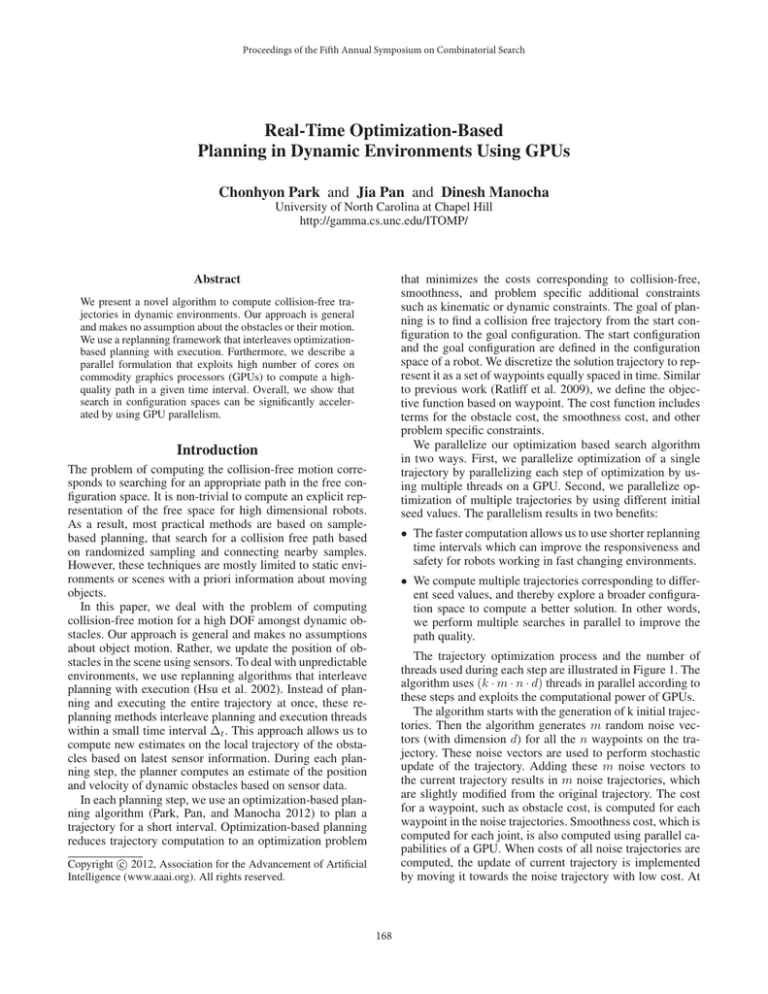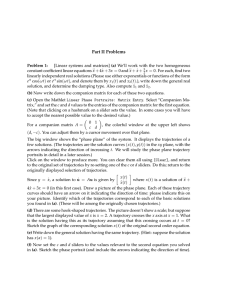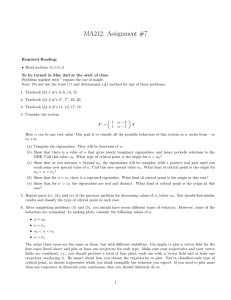
Proceedings of the Fifth Annual Symposium on Combinatorial Search
Real-Time Optimization-Based
Planning in Dynamic Environments Using GPUs
Chonhyon Park and Jia Pan and Dinesh Manocha
University of North Carolina at Chapel Hill
http://gamma.cs.unc.edu/ITOMP/
Abstract
that minimizes the costs corresponding to collision-free,
smoothness, and problem specific additional constraints
such as kinematic or dynamic constraints. The goal of planning is to find a collision free trajectory from the start configuration to the goal configuration. The start configuration
and the goal configuration are defined in the configuration
space of a robot. We discretize the solution trajectory to represent it as a set of waypoints equally spaced in time. Similar
to previous work (Ratliff et al. 2009), we define the objective function based on waypoint. The cost function includes
terms for the obstacle cost, the smoothness cost, and other
problem specific constraints.
We parallelize our optimization based search algorithm
in two ways. First, we parallelize optimization of a single
trajectory by parallelizing each step of optimization by using multiple threads on a GPU. Second, we parallelize optimization of multiple trajectories by using different initial
seed values. The parallelism results in two benefits:
We present a novel algorithm to compute collision-free trajectories in dynamic environments. Our approach is general
and makes no assumption about the obstacles or their motion.
We use a replanning framework that interleaves optimizationbased planning with execution. Furthermore, we describe a
parallel formulation that exploits high number of cores on
commodity graphics processors (GPUs) to compute a highquality path in a given time interval. Overall, we show that
search in configuration spaces can be significantly accelerated by using GPU parallelism.
Introduction
The problem of computing the collision-free motion corresponds to searching for an appropriate path in the free configuration space. It is non-trivial to compute an explicit representation of the free space for high dimensional robots.
As a result, most practical methods are based on samplebased planning, that search for a collision free path based
on randomized sampling and connecting nearby samples.
However, these techniques are mostly limited to static environments or scenes with a priori information about moving
objects.
In this paper, we deal with the problem of computing
collision-free motion for a high DOF amongst dynamic obstacles. Our approach is general and makes no assumptions
about object motion. Rather, we update the position of obstacles in the scene using sensors. To deal with unpredictable
environments, we use replanning algorithms that interleave
planning with execution (Hsu et al. 2002). Instead of planning and executing the entire trajectory at once, these replanning methods interleave planning and execution threads
within a small time interval ∆t . This approach allows us to
compute new estimates on the local trajectory of the obstacles based on latest sensor information. During each planning step, the planner computes an estimate of the position
and velocity of dynamic obstacles based on sensor data.
In each planning step, we use an optimization-based planning algorithm (Park, Pan, and Manocha 2012) to plan a
trajectory for a short interval. Optimization-based planning
reduces trajectory computation to an optimization problem
• The faster computation allows us to use shorter replanning
time intervals which can improve the responsiveness and
safety for robots working in fast changing environments.
• We compute multiple trajectories corresponding to different seed values, and thereby explore a broader configuration space to compute a better solution. In other words,
we perform multiple searches in parallel to improve the
path quality.
The trajectory optimization process and the number of
threads used during each step are illustrated in Figure 1. The
algorithm uses (k · m · n · d) threads in parallel according to
these steps and exploits the computational power of GPUs.
The algorithm starts with the generation of k initial trajectories. Then the algorithm generates m random noise vectors (with dimension d) for all the n waypoints on the trajectory. These noise vectors are used to perform stochastic
update of the trajectory. Adding these m noise vectors to
the current trajectory results in m noise trajectories, which
are slightly modified from the original trajectory. The cost
for a waypoint, such as obstacle cost, is computed for each
waypoint in the noise trajectories. Smoothness cost, which is
computed for each joint, is also computed using parallel capabilities of a GPU. When costs of all noise trajectories are
computed, the update of current trajectory is implemented
by moving it towards the noise trajectory with low cost. At
c 2012, Association for the Advancement of Artificial
Copyright Intelligence (www.aaai.org). All rights reserved.
168
Scenario
CPU 1 core
CPU 2 core
CPU 4 core
GPU 1 trajectory
GPU 4 trajectory
GPU 10 trajectory
Std. dev. planning time
0.339
0.284
0.180
0.204
0.326
0.071
Table 1: Results obtained from our trajectory computation
algorithm based on different levels of parallelization and
number of trajectories (for the benchmarks shown in Figure 2(a)). The planning time decreases when the planner
uses more trajectories.
Figure 1: The detailed breakdown of GPU trajectory optimization. It starts with the generation of k initial trajectories. From these initial trajectories, the algorithm iterates
over stochastic optimization steps. First it generates random
noise vectors which are used for stochastic optimization,
then computes the cost for each waypoint on each noise trajectory. We also compute joint cost. The current trajectory
cost is repeatedly improved using the cost of noise trajectories until the algorithm satisfies termination criteria.
(a) An environment with
two static and two dynamic obstacles.
Average planning time
810
663
622
337
203
60
Figure 3: Results obtained from the replanning in dynamic
environments on a multi-core CPU and a many-core GPU.
The use of multiple trajectories in our replanning algorithm
results in trajectories with lower costs and thereby, improved
quality.
(b) An environment with a
human obstacle.
that the GPU-based planner demonstrates more than 10X
speedup over the multi-core CPU-based planner. In both
cases, it is shown that when more trajectories are optimized
in parallel, the performance of the planner and the quality of
resulting paths increases.
In the next experiment, we test our parallel replanning
algorithm in dynamic environments with a high number
of moving obstacles. The obstacles in the environments
change their velocities periodically. However, this information about the obstacles is not known to the planner. The
planner uses a replanning technique to reach the goal while
avoiding collisions with the obstacles. We observe a different level of responsiveness between CPU and GPU-based
planners. When the obstacles move at a high speed, the
CPU-based planner may not be responsive. Moreover, we
measure the cost of computing the entire solution trajectory,
including robot execution. The cost used in this experiment
consists of two costs, obstacle cost and smoothness cost. We
measure the cost with varying number of optimized trajectories in order to measure the effect of parallelization. Figure 3
highlights the performance. As the number of optimized trajectories increases, the overall cost of entire trajectory computation decreases. This result validates that the multiple trajectory optimization improves the quality of the solution.
Figure 2: Planning environments used to evaluate the performance of our planner. The planner computes a trajectory of
high DOF PR2 robot arm, which avoids dynamic obstacles
and moves horizontally from right to left. The green and red
spheres correspond to static and dynamic obstacles, respectively.
the end of each iteration, the algorithm decides to stop the
optimization or repeat the next iteration. If a trajectory is
classified as being globally optimal, the optimization computation of all trajectories is interrupted and the globally optimal solution is returned. Or if the given time budget is expired, similarly, optimization of all trajectories is interrupted
and the best solution is returned.
Results
Our first experiment is designed to estimate the responsiveness of the planner. We plan a trajectory of the 7 degree-offreedom right arm of PR2 in a simulation environment. In
the environment shown in Figure 2(a), there are two static
(green) and two moving (red) obstacles. We measure the
elapsed time to compute a collision-free solution with varying number of trajectories for both CPU and GPU-based
planners. This experiment is performed to compute the appropriate time interval for a single planning time step during replanning. A shorter planning time makes the planner
more responsive. The result is shown in Table 1. We observe
Conclusions
We present a novel, parallel algorithm for real-time replanning in dynamic environments. The underlying planner uses
an optimization-based formulation and we obtain significant
169
speed-ups and improved reliability by exploiting the parallelism on many-core GPUs.
Acknowledgments
This research is partially supported by NSF grants 1000579,
1117127, and 1142382.
References
Hsu, D.; Kindel, R.; Latombe, J.-C.; and Rock, S. 2002. Randomized kinodynamic motion planning with moving obstacles. International Journal of Robotics Research 21(3):233–255.
Park, C.; Pan, J.; and Manocha, D. 2012. ITOMP: Incremental
trajectory optimization for real-time replanning in dynamic environments. In Proceedings of the International Conference on Automated Planning and Scheduling, to appear.
Ratliff, N.; Zucker, M.; Bagnell, J. A. D.; and Srinivasa, S. 2009.
CHOMP: Gradient optimization techniques for efficient motion
planning. In Proceedings of International Conference on Robotics
and Automation, 489–494.
170







